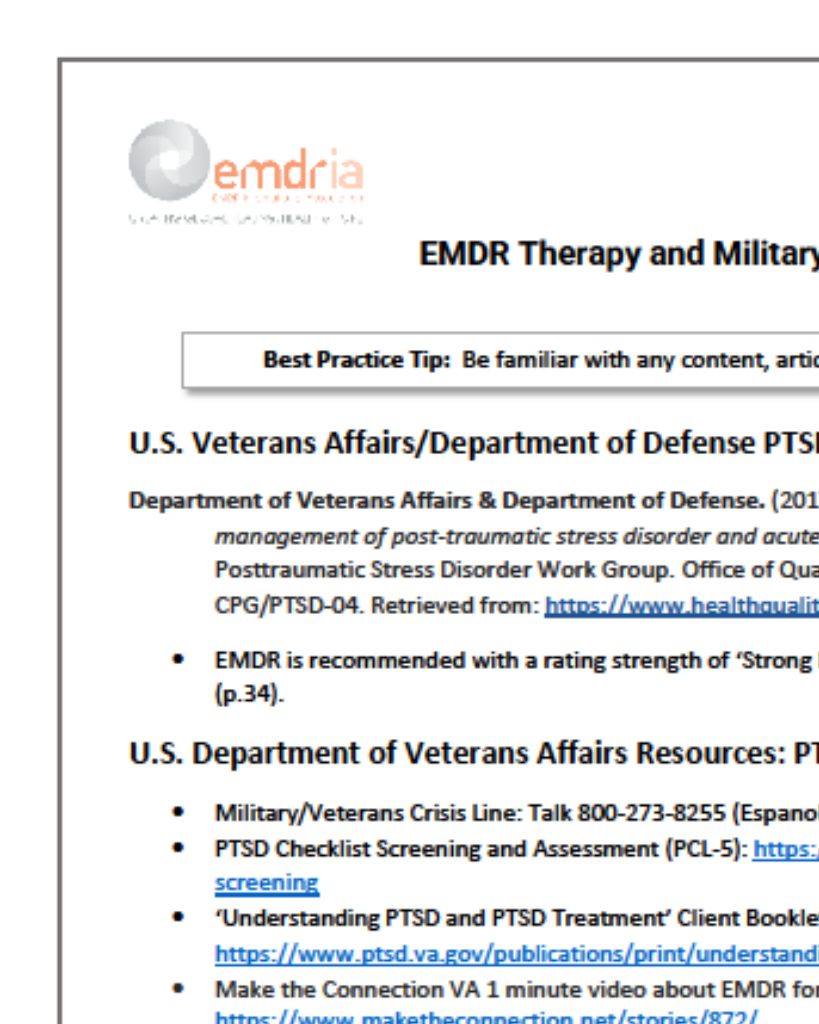Childbirth-related posttraumatic stress disorder: Definition, risk factors, pathophysiology, diagnosis, prevention, and treatment
EMDR can be used to ensure that people with childbirth-related PTSD are treated to recovery so that it does not become chronic.
Article Abstract
“Psychological birth trauma and childbirth-related posttraumatic stress disorder represent a substantial burden of disease with 6.6 million mothers and 1.7 million fathers or co-parents affected by childbirth-related posttraumatic stress disorder worldwide each year. There is mounting evidence to indicate that parents who develop childbirth-related posttraumatic stress disorder do so as a direct consequence of a traumatic childbirth experience. High-risk groups, such as those who experience preterm birth, stillbirth, or preeclampsia, have higher prevalence rates. The main risks include antenatal factors (eg, depression in pregnancy, fear of childbirth, poor health or complications in pregnancy, history of trauma or sexual abuse, or mental health problems), perinatal factors (eg, negative subjective birth experience, operative birth, obstetrical complications, and severe maternal morbidity, as well as maternal near misses, lack of support, dissociation), and postpartum factors (eg, depression, postpartum physical complications, and poor coping and stress).
The link between birth events and childbirth-related posttraumatic stress disorder provides a valuable opportunity to prevent traumatic childbirths and childbirth-related posttraumatic stress disorder from occurring in the first place. Childbirth-related posttraumatic stress disorder is an extremely distressing mental disorder and has a substantial negative impact on those who give birth, fathers or co-parents, and, potentially, the whole family. Still, a traumatic childbirth experience and childbirth-related posttraumatic stress disorder remain largely unrecognized in maternity services and are not routinely screened for during pregnancy and the postpartum period. In fact, there are gaps in the evidence on how, when, and who to screen.
Similarly, there is a lack of evidence on how best to treat those affected. Primary prevention efforts (eg, screening for antenatal risk factors, use of trauma-informed care) are aimed at preventing a traumatic childbirth experience and childbirth-related posttraumatic stress disorder in the first place by eliminating or reducing risk factors for childbirth-related posttraumatic stress disorder. Secondary prevention approaches (eg, trauma-focused psychological therapies, early psychological interventions) aim to identify those who have had a traumatic childbirth experience and to intervene to prevent the development of childbirth-related posttraumatic stress disorder. Tertiary prevention (eg, trauma-focused cognitive behavioural therapy and eye movement desensitization and reprocessing) seeks to ensure that people with childbirth-related posttraumatic stress disorder are identified and treated to recovery so that childbirth-related posttraumatic stress disorder does not become chronic.
—Description from publisher
Article Access
Open Access
Horsch, A., Garthus-Niegel, S., Ayers, S., Cahndra, P., Hartmann, K., Vaisbuch, E., & Lalor, J. (2024). Childbirth-related posttraumatic stress disorder: Definition, risk factors, pathophysiology, diagnosis, prevention, and treatment. American Journal of Obstetrics & Gynecology. Open access: https://doi.org/10.1016/j.ajog.2023.09.089
Date
March 1, 2024
Creator(s)
Antje Horsch, Susan Garthus-Niegel, Susan Ayers
Contributor(s)
Prabha Chandra, Katharina Hartmann, Edi Vaisbuch, Joan Lalor
Topics
PTSD, Pregnancy/Perinatal
Extent
12 pages
Publisher
Elsevier
Rights
© 2023 The Author(s). Published by Elsevier Inc.
APA Citation
Horsch, A., Garthus-Niegel, S., Ayers, S., Cahndra, P., Hartmann, K., Vaisbuch, E., & Lalor, J. (2024). Childbirth-related posttraumatic stress disorder: Definition, risk factors, pathophysiology, diagnosis, prevention, and treatment. American Journal of Obstetrics & Gynecology. Open access: https://doi.org/10.1016/j.ajog.2023.09.089
Audience
EMDR Therapists, Other Mental Health Professionals
Language
English
Content Type
Article, Peer-Reviewed
Access Type
External Resource, Open Access




